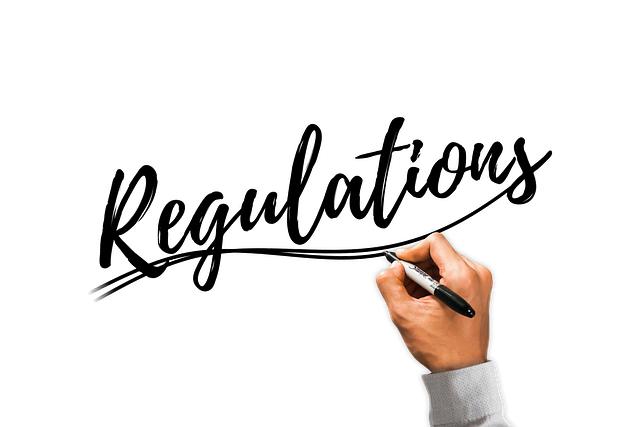In the intricate dance of global finance, where trillions of dollars ebb and flow across borders each day, the unseen hand of regulation orchestrates a symphony of stability and innovation. As the world becomes increasingly interconnected, the role of financial regulations has evolved from mere oversight to a powerful force shaping the future of finance. These regulations, crafted in the halls of international institutions and national governments, are not just guardrails but are now pivotal in steering the course of economic progress and technological advancement. In this era of rapid digital transformation, where cryptocurrencies challenge traditional norms and fintech startups disrupt established paradigms, understanding the impact of global financial regulations is more crucial than ever. This article delves into the complex yet fascinating world of financial regulations, exploring how they are redefining the landscape of finance and what this means for the future of economies worldwide.
Navigating the Regulatory Labyrinth: Unveiling the Impact on Global Finance
In an era where finance knows no borders, the intricate web of international regulations has become a defining force in shaping the future of global finance. The financial landscape is continuously evolving, driven by a complex array of regulatory frameworks designed to foster stability, transparency, and ethical practices. Navigating this regulatory labyrinth requires financial institutions to adapt swiftly, ensuring compliance while pursuing innovation. The challenge lies in harmonizing diverse regulations across jurisdictions, which often leads to a delicate balancing act between maintaining competitive advantage and adhering to stringent rules.
Financial regulations impact the global economy in multifaceted ways, including:
- Risk Management: Stricter capital requirements and stress testing protocols are designed to prevent financial crises but can also limit the agility of financial institutions.
- Technological Innovation: Regulations like GDPR and PSD2 in Europe encourage the development of secure and consumer-friendly financial technologies, fostering a more inclusive financial ecosystem.
- Cross-Border Transactions: Harmonization efforts such as Basel III aim to streamline international banking operations, yet differences in local implementation can create friction.
Ultimately, the ongoing evolution of global financial regulations not only seeks to safeguard the financial system but also sets the stage for a more resilient and dynamic financial future.

The Rise of Digital Currencies: Regulatory Challenges and Opportunities
The evolution of digital currencies is not just a technological revolution; it is a regulatory frontier that presents both challenges and opportunities for global finance. As governments and financial institutions grapple with the rapid proliferation of cryptocurrencies, regulatory frameworks are being crafted to ensure stability, security, and compliance. This dynamic landscape is characterized by a delicate balance between fostering innovation and protecting consumers. Key regulatory challenges include:
- Ensuring anti-money laundering (AML) and combating the financing of terrorism (CFT) compliance.
- Addressing concerns related to consumer protection and fraud prevention.
- Establishing clear tax policies for digital asset transactions.
Amidst these challenges, opportunities abound. Regulators have the chance to create innovative policies that not only safeguard the financial system but also encourage the growth of fintech ecosystems. By adopting a forward-thinking approach, countries can position themselves as leaders in the digital currency space, attracting investment and talent. This regulatory evolution is shaping a new era of finance, where digital currencies can coexist with traditional financial systems, offering unprecedented accessibility and efficiency.

Harmonizing Standards: A Blueprint for Cross-Border Financial Cooperation
In an increasingly interconnected world, the harmonization of financial standards across borders is not just a lofty ideal but a necessity for sustainable global economic growth. The alignment of regulations ensures that financial markets operate smoothly, reducing the risk of systemic failures and fostering investor confidence. Global financial regulations are the scaffolding upon which the future of finance is being constructed, facilitating seamless transactions and leveling the playing field for both established institutions and emerging fintech innovators.
Key benefits of this harmonization include:
- Reduced compliance costs for multinational corporations, allowing them to allocate resources more efficiently.
- Increased transparency in financial reporting, leading to more informed decision-making by investors.
- Enhanced risk management through standardized protocols, which mitigate the potential for financial crises.
As regulatory bodies across the globe collaborate, the blueprint for cross-border financial cooperation is taking shape, promising a future where financial stability and innovation can coexist and thrive.

Strategic Adaptation: Recommendations for Thriving in a Regulated Future
In a world where financial regulations are evolving at a rapid pace, businesses must embrace strategic adaptation to ensure their longevity and success. To thrive in this regulated future, organizations should consider the following recommendations:
- Invest in Compliance Infrastructure: Building a robust compliance framework is no longer optional. Companies should allocate resources to develop advanced systems that can seamlessly integrate regulatory requirements into their operations.
- Leverage Technology: Utilize cutting-edge technologies such as artificial intelligence and blockchain to enhance transparency and efficiency. These tools can help in monitoring compliance and predicting regulatory changes.
- Foster a Culture of Agility: Encourage a mindset that embraces change. Training employees to adapt quickly to new regulations will empower your organization to pivot and respond effectively to unforeseen challenges.
- Engage with Regulators: Proactively engaging with regulatory bodies can provide insights into upcoming changes and allow for better preparation. Building relationships with regulators can also offer opportunities to influence policy development.
By implementing these strategies, financial institutions can not only navigate the complexities of global regulations but also capitalize on new opportunities that arise in a regulated landscape.





